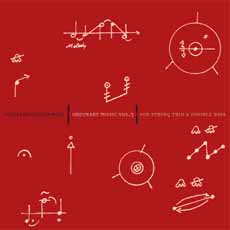
ordinary music vol. 3
for string trio & double bass
Nikolaus Gerszewski
cs136
Music as non-representational art: ordinary music
Nikolaus Gerszewski has been writing music as an autodidact since 2003.
In 2007, he developed an individual form of notation for his “Ordinary
Music”. Formerly, he had worked as a visual artist and art critic.
His interest was focussed on different kinds of so-called “abstract”,
“concrete” or “non-representational” painting:
informal, constructivism, abstract expressionism, radical painting, minimal
art, lyrical abstraction, action painting and optical art. It was this
kind of art that had a decisive influence on New York contemporary music
of the 50s and 60s. Similar to New York School music, “Ordinary
Music” can be described as a continuation of abstract visual thinking
by means of sound, a kind of “sound painting”: music appearing
in terms of “sound spaces”, “sound surfaces”,
“sound layers” or “sound objects”.
This change in musical comprehension - from an art form developed within
time to one unfolded within space - required its equivalent in terms of
notation. The score of “Ordinary Music Vol.3” visualizes a
possible simultaneity of sound events, to be combined (put in sequence,
layered, intermingled) in real time by the players: an ad-hoc composition
with predetermined material.
The material: slides, tremoli, harmonics, held tones, patterns, distortions,
beating waves or noises (white noise, knocking, whistling etc.) noted
in diagrams - partly as sound descriptions, partly as technical instructions
- can be performed by musical laymen just as well as by professional musicians.
In the instructions it says: “It might take some rehearsal to acquire
the perceptiveness it takes, but in principal there are no preconditions
regarding musical education”.
Nikolaus Gerszewski has studied and performed scores by Cage (Four6),
Cardew (Treatise) and Christian Wolff (Edges, Prose Collection). The decisive
impulse, however, came from an entirely different direction: “Since
October 2007, I have been visiting a Yoga class. The experience of how
to change the body perception by breathing, muscle straining and ankle
stretching brought me the idea of creating music that consists in the
most basic exercises: for the fingers, the wrist, the shoulder, the ear,
the breath, the concentration or the coordination.” For the listener,
“Ordinary Music” becomes accessible through a mental tracing
of the sound surface. Just like the spectator of a De Kooning painting
could recall the creative act by tracing the brush strokes. “Ordinary
Music” wants to make the composition process audible. Its performance
is understood as a process of collective searching. And the music unfolds
as if by coincidence.
The premiere of “Ordinary Music Vol.3” in Lisbon took place
without any advance rehearsal; there was only a short discussion right
before the concert.
Karl
Messer